Platelet activation in cats with hypertrophic cardiomyopathy
- PMID: 24612013
- PMCID: PMC4857988
- DOI: 10.1111/jvim.12325
Platelet activation in cats with hypertrophic cardiomyopathy
Abstract
Background: Cats with hypertrophic cardiomyopathy (HCM) are at risk for development of systemic thromboembolic disease. However, the relationship between platelet activation state and cardiovascular parameters associated with HCM is not well described.
Objectives: To characterize platelet activation by flow cytometric evaluation of platelet P-selectin and semiquantitative Western blot analysis of soluble platelet-endothelial cell adhesion molecule-1 (sPECAM-1).
Animals: Eight normal healthy cats (controls) owned by staff and students of the School of Veterinary Medicine and 36 cats from the UC Davis Feline HCM Research Laboratory were studied.
Methods: Platelet-rich plasma (PRP) was used for all flow cytometry studies. Platelet surface CD41 and P-selectin expression were evaluated before and after ADP stimulation. sPECAM-1 expression was evaluated by Western blot analysis of platelet-poor plasma that had been stabilized with aprotinin. Standard echocardiographic studies were performed.
Results: Resting platelets from cats with severe HCM had increased P-selectin expression compared to controls, and expressed higher surface density of P-selectin reflected by their increased mean fluorescence intensities (MFI). Stimulation with ADP also resulted in significantly increased P-selectin MFI of platelets from cats with severe HCM. Increased P-selectin expression and MFI correlated with the presence of a heart murmur and end-systolic cavity obliteration (ESCO). sPECAM-1 expression from cats with moderate and severe HCM was significantly increased above those of control cats.
Conclusions and clinical importance: P-selectin and sPECAM expression may be useful biomarkers indicating increased platelet activation in cats with HCM.
Keywords: Hypertrophic cardiomyopathy; P-selectin; Platelet activation; Platelets; sPECAM-1.
Copyright © 2014 by the American College of Veterinary Internal Medicine.
Figures
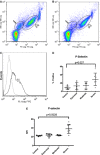
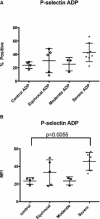
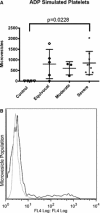
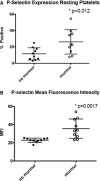

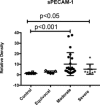
References
-
- Meurs KM, Norgard MM, Kuan M, et al. Analysis of 8 sarcomeric candidate genes for feline hyypertorphic cardiomyopathy mutations in cats with hypertrophic cardiomyopathy. J Vet Intern Med 2009;23:840–843. - PubMed
-
- Meurs KM, Norgard MM, Ederer MM, et al. A substitution mutation in the myosin binding protein C gene in Ragdoll hypertrophic cardiomyopathy. Genomics 2007;90:261–264. - PubMed
-
- Abbott JA. Feline hypertrophic cardiomyopathy: An update. Vet Clin Small Anim 2010;40:687–700. - PubMed
-
- Kittleson MD, Meurs KM, Munro MJ, et al. Familial hypertrophic cardiomyopathy in Maine Coon cats: An animal model of human disease. Circulation 1999;99:3172–3180. - PubMed
Publication types
MeSH terms
Substances
LinkOut - more resources
Full Text Sources
Other Literature Sources
Research Materials
Miscellaneous

